#also in researching this i was reminded of the existence of Pedro & Me
Explore tagged Tumblr posts
Text
Trans Man Noah Diaz
The first time I saw Rise of the Beasts, I read Noah as a Trans Man, and that headcanon just solidified after my second viewing.
I’ll get the heavy reasons out of the way first, and work down to the most silly ones.
The section that was here before has been removed, because I was overstepping and someone rightly called me out on it. However. I’m not going to lie and pretend I didn’t do what I did. I deleted the comment that called me out because it made me feel bad, I panicked, and deleted it to save my own ego. It was wrong, it was cowardly, it was fucked up, and I shouldn’t have done it.
I truly am sorry, and have spent the last day sitting with myself until I stopped trying to excuse my behavior and just acknowledged what I did. I am not asking for forgiveness, I can only try going forward to be the kind of person deserving of it.
For now, I’m taking a break from this blog, leaving it on a queue, and I won’t be posting here for a while. Even though that isn’t the kind of person I want to be, I need to reckon with the fact that that is the kind of person I am. I’m sorry, once again.
1994 was also the year Don’t Ask, Don’t Tell was put into place, which, for those too young to remember, was basically a policy allowing queer and trans people to serve in the military so long as they remained closeted, and prohibited superiors from forcibly outing them. Given that we’re never actually told in the film why Noah was discharged, it’s not unreasonable to think that it may have been because he got found out as trans.
The part that’s particularly personal for me is his relationship with Kris. I’ve also got a little brother that’s quite a bit younger than me, and I acted as an extra parent to him, practically raised him since we were both latchkey kids, and yeah, there’s no doubt in my mind that I’d face the apocalypse head on if it meant keeping him safe. All that to say, it’s comforting to think that Noah’s identity as a man is inseparable from his identity as a Big Brother, the way it is for me.
Most of my other reasons are less serious:
Noah wears a lot of layers and baggy clothes on his upper half, which yes, was part of 90s fashion, but it’s also how I dressed for most of my life, even before I realized I was trans.
Noah is also non-toxically masculine in a way that’s not unheard of but also not as common for men, especially service members, of that time period. Again, there may very well be a cultural component I’m missing here, let me know if there is, but this is just something I related to as a Guy Who Wasn’t Raised As One.
This last one’s kinda silly, but I’m a Car Guy, and one of the most gender euphoria inducing things I can do is work on my car. There’s few things that make me feel like Man quite like sweat on my brow and grease on my hands and a purring engine from a job well done. So for Noah to not only be a tech wiz but specifically a Mechanic? That was the thing that really sold me on this headcanon. (And that’s not even getting into the very fun implications of Noah being the one to repair Mirage, to get to know him so intimately, literally inside and out. Very nice.)
(I also love the idea that rather than being weirded out or taken aback at first like he is in some fics, Noah would be kinda weirdly affirmed to find out that not only does Mirage have some of roughly the same *equipment* while still being treated as and being a Mech, but his setup is the norm for Cybertronians. I can so picture Noah anxiously telling Mirage about his situation when they finally get together only for Mirage to be like “you mean other human mechs don’t have a 🐈??? Like, most humans only have one or the other?????”)
#Transformers#Noah Diaz#Trans Man Noah Diaz#Noah/Mirage#Rise of the Beasts#Miroah#TF: RotB#Transformers Rise of the Beasts#Mirage#trans headcanon#also in researching this i was reminded of the existence of Pedro & Me#it's a really good graphic novel by Judd Winick about his friend Pedro Zamora#they appeared on the 1994 season of MTV's The Real World#Pedro was the first positive depiction a lot of Americans got of an HIV+ gay man#he unfortunately died late that same year#sorry for rambling comic books are one of my special interests#anyway it's a good book you should read it if you can
103 notes
·
View notes
Text
Newish Comics: 3 April 2025
Batgirl #5: Tate Brombal is doing a lot here merging various storylines together to come up with a throughline and it’s really interesting watching him pick up and reference old imagery. There’s a lot of satisfying nuance going on here.
Birds of Prey #19: and a tidy wrap up to this storyline. I’m finding what Kelly Thompson is doing with Megaera here remains really interesting, but still very very Monstress in detail. Always glad to see Babs get to be Oracle properly and she was here.
The Nice House by the Sea #6: so. much. drama. After the shock revelations of last issue, Max is continuing to be an absolute shit and Norah is so trapped by knowing too much but not being respected for her knowledge. Max is really hammering in on her feelings of isolation and identity issues. Also generally with the houses, we’re really focusing in on the difference between grind mindset and the connection from shared childhoods in terms of what ‘exceptional’ means.
We are now on the mid-storyline hiatus; it might be time to read back over the existing 18 issues again as I wait for the second half of this storyline.
Poison Ivy #31: already missing Marcio Takara’s art. Brian Level’s is just not the same and feels almost too cartoony for the storyline. I had to laugh at Pam just going ‘oh mould in your house isn’t a problem unless you’re allergic’ – I see the villain edge is back, here, the research does not say that, Ivy. An interesting discussion of what counts as ecoterrorism here, both from the side of our plant villains harming others and from regular humans trying to control and alter the environment to live in it.
Secret Six #1: this is very teen angsty. SO teen angsty. Also not beating the accusations of this all being about Maines’ special kids. I’m not particularly convinced by this take on Lori, but she is known to enjoy riling up people she sees as too goody goody, I suppose.
Shazam! #21: the finale. I’m sorry to see this finish, but if it had to go out, I’m glad it was on a Mister Mind AND Georgia Sivana story. Top notch Shazam villains! Campbell tidied up a lot of plot threads, actually gave Eugene and Pedro something to do in the finale (mostly offscreen but that’s progress from the rest of the run), and really reminded me that she’s definitely been deeply caught up in thoughts about what makes family family recently (which…isn’t a huge surprise given she’s been on maternity leave).
I’m not really feeling any impetus from this to go back and get my head around what happened in the #20 fill, so I shall not.
Two-Face #4: I have already burbled about this so much but in short: this hit me exactly in the feels and in my personal interests. Amazing issue. Framing the Trial of Harvey Dent issue as a family law custody dispute, rather than the standard criminal trial was a stroke of genius and how it should always be characterised from now on. I am in love. Just so nuanced and intelligent about the whole approach and in transforming the psychological and legal aspects of the whole situation into something that many people understand intimately.
On The Reaper watch: unfortunately he’s only here in the story as part of the hallucination, but he does get to tie Two-Face down with his blades.
The Warlord #91: this week in the lost land of Skartaris, we are retreading Travis Morgan’s backstory and origin. We get to see young Travis remembering standing up to a bully in middle school, of which the most striking point to note is that even as a pre-teen Travis had his white hair. What’s even more interesting is that while Jennifer has white hair now (in her early 20s), we also get a flashback here showing her with ordinary blonde hair as a small child.
We also get some return to bondage (someone trapped by being pinned by crossbow bolts through the palms of the hand to a wall) but sadly this is not Travis.

And even more tragically, after this chin lift they kill him, rather than go into the obvious fanfic scenario that accompanies such a moment.

Travis does find the opportunity to have his clothes torn from his body, however, but this is mostly just part of the retelling on 1st Issue Special yet again.
Also in exciting news today, Joshua and Tara are in the same place at the same time for the first time since he was taken as a baby and all the cloning problems. Look! He can see his mother!

(it of course gets turned into angst on both their parts as they do not recognise each other)
11 notes
·
View notes
Note
Meda!! i am in TEARS!!!!!!! your response to my last ask was so so so so so nice and I am giving you the biggest, warmest hug!!!!! we are definitely bunkmates at summer camp!!!!!!! I'll be the weird kid who's always sharing strange, niche, and macabre historical facts lol 😅 but I'll make up for it by making yummy treats bc I love baking ☺️
(putting a cut here bc this got long - sorry😅)
and you think about me sometimes???? 🥹🥹🥹🥹 I am so SOFT 🥹🥹🥹🥹 as you said, I know we're internet friends who have never met, but I think about you as well and send you good vibes always!! sometimes I'll see something I think you'd like - like a Pedro Pascal meme or something - and I'll think to myself, "oh, Meda would like this!" 💙
and huge congrats on finishing up the semester!! and my goodness I totally get you about feeling kinda worthless if there's nothing academic to validate my existence 😅 I wish I could give you some words of encouragement with that, but honestly it's something I'm still unpacking with my therapist and trying to work through myself. but I think I can offer this if it's of any help: since I don't know you in an academic context (I don't know what classes you take, what grades you get, etc.) I can tell you that you have so much value outside of academics. your writing is incredible, and you are such a kind, welcoming, warm person. I am so lucky to know you (even if only virtually) and you bring such light to everyone with whom you interact. while I know that academics/the grading system can really fuck with your sense of self and self-worth, just know that you are a whole and complete person outside of those things, and you are valued, appreciated, and loved for all the wonderful and unique things you bring just by being yourself. 🥰🥰🥰🥰
and I also brought stickers!! I didn't have all the animals you mentioned, so I threw in a few others that I thought were really cute (and a red panda bc they're my favorite ☺️). since you're already done with your semester, they can be celebration stickers!!
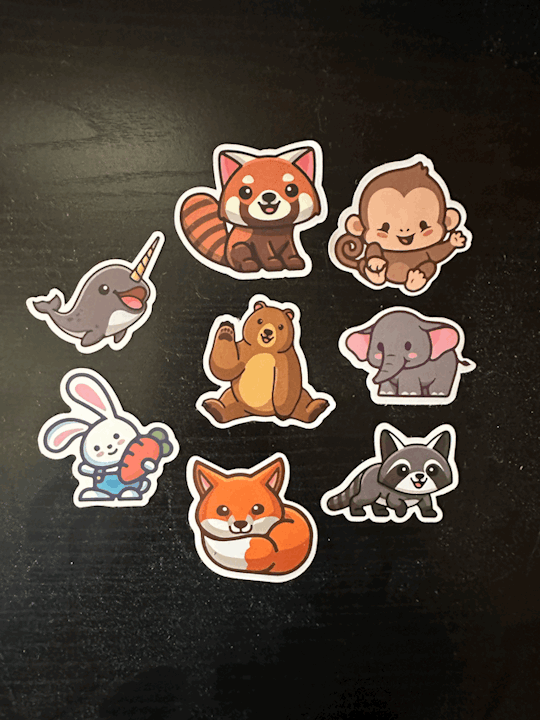
and thank you so much for the well-wishes on my MA and for the summer! I'll be applying to phd programs in the fall so I'll be researching and reaching out to profs over the summer (pray for me 😬). but I do hope to have some time to just relax and make edits and write. oh and we're getting a new puppy in June!!! I will be sure to send photos!!
I also wish you rest when you need it and creative inspiration when you want it this summer!!
I'll be over here in my bunk at summer camp, so reach out absolutely any time! 🥰
sending you love, hugs, and all things good,
charlotte 🎨
Of course I think about ya!! It's little things that remind me so much of you. Like I have these vintage style flower stickers I use pretty often to decorate things and they remind me entirely of you. And almost every time I hear a Taylor Swift song it makes me think of you too!!
And oh gosh, you're talking to a person who, as a kid, was massively hyperfixated on learning everything I possibly could about the Titanic, the Kennedy assassinations, and like every true crime case I'd learn about on TV. So we would definitely be the weird summer camp kids together, just swapping our weird little fun facts and treats with each other (because I'm also a huge baker)!!
(I'm also adding a cut here because whOO so many paragraphs of things for me to say)
That entire paragraph you left...is so affirming and so lovely and I just– I have no words to express how wonderful it was to read that. Thank you. I also feel incredibly lucky to know a person like you with such a massively generous and kind heart and a vastly wonderful taste in the arts. And I can say that even just through my computer screen, you bring me so much joy, so I can assure you that to the people who get to interact with you in real life? You must absolutely radiate pure light.
Maybe you can relate a little bit to this? But growing up, the only thing that I was ever really taught to value about myself was how I was doing in school. I was taught to always prioritize productivity. So now as an adult, it's so hard to justify giving myself breaks and just letting myself find peace and happiness in the quiet. These are all things I'm working on in therapy, and the approach that my therapist has given me is just like...viewing myself as a stranger.
Because if I were looking at any other person who does the things I do and is the kind of person I try to be...I would love them. I would do everything in my power to support them and make them feel as loved and valued and cared for as possible. It's a little bit easier to give myself kindness with that level of removal there. Maybe that's helpful to you, maybe it isn't!! Either way, I thought I'd share it. 💞
AND OKAY MASSIVE TONE SHIFT BUT OH MY GOODNESS CHARLOTTE THOSE STICKERS ARE ALL THE ABSOLUTE CUTEST THINGS EVER. GOSH THOSE MADE ME SMILE SO BIG I LOVE THEM SO MUCH. Thank you so much for the celebration stickers and gosh, next time I find some adorable stickers, I'll have to send them to you as well!! Just to spread the sticker love around!! 🥰
Goodness gracious, wishing you the absolute best with your academic pursuits this summer!! And I'd just love to see pictures of your puppy when you get them!! Very much looking forward to what this summer brings for both of us, bunkmate. I'm sending all of your hugs and thoughts of love and support right back at ya!! 💞✨
2 notes
·
View notes
Text
Research: Project Finish
Tim Sale
Tim Sale is a famous comic book artist, who had worked in several titles along with the writer Jeff Loeb, including Batman, Spider-Man, Superman, Daredevil, and many others.
Tim Sale was born in may of 1956, in New York, where he studied visual arts, spent a good time of his life in Seattle, and today he lives in California.
For some years he drew his art privately, only to please himself. When he found himself working at a fast food in his late twenties, however, he decided to try to sell some of his work. This led to an association with Thives’ World Graphics, a fantasy anthology series, where he illustrated stories.
What most marks his work is the dramatic aspect that he manages to obtain in the characterization of his characters and in the scenarios he creates, making the stories unique and immortalizing the characters.
The union of Sale’s art with Loeb’s engaging narrative has become the perfect marriage for mysterious plots.
One of the most striking characters worked by Sale was Batman, which he drew “The Long Halloween”, “Dark Victory” and “Halloween”. He was able to fully transfigure the dark aura of Gotham and his Dark Knight. He also worked with Superman in the saga “ Superman for All Seasons”.
Both of The Long Halloween and For All Seasons are what is known as “Year one” comics. These works take their heroes back in time to their earliest days of crime fighters.
His main tool is watercolor, which he uses with mastery. Sale's palette of colors is something really impressive, always drawing and painting his characters very delicately, and calmly. His style is very cartoonish, although this does not diminish his art in any way, on the contrary, his style is very unique and characteristic.
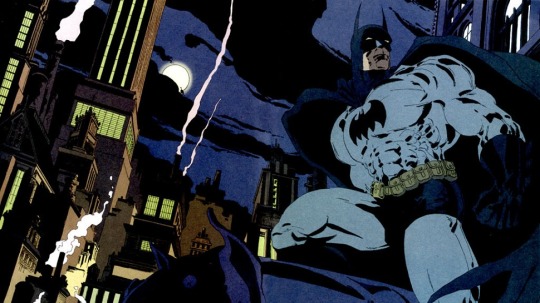
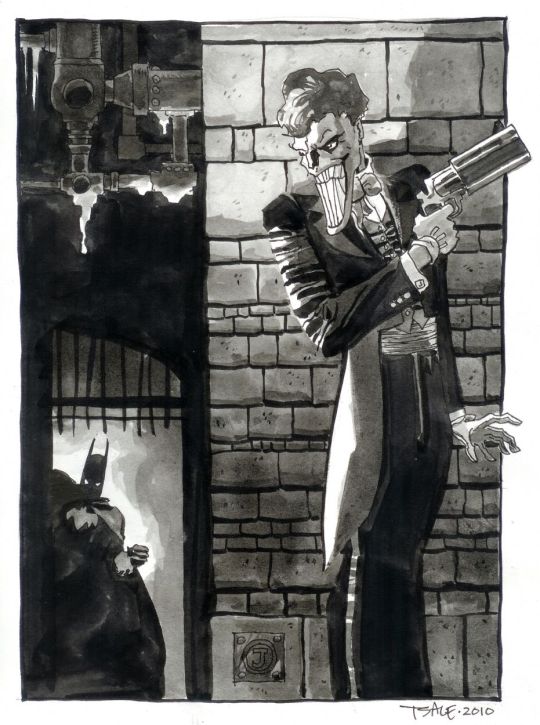


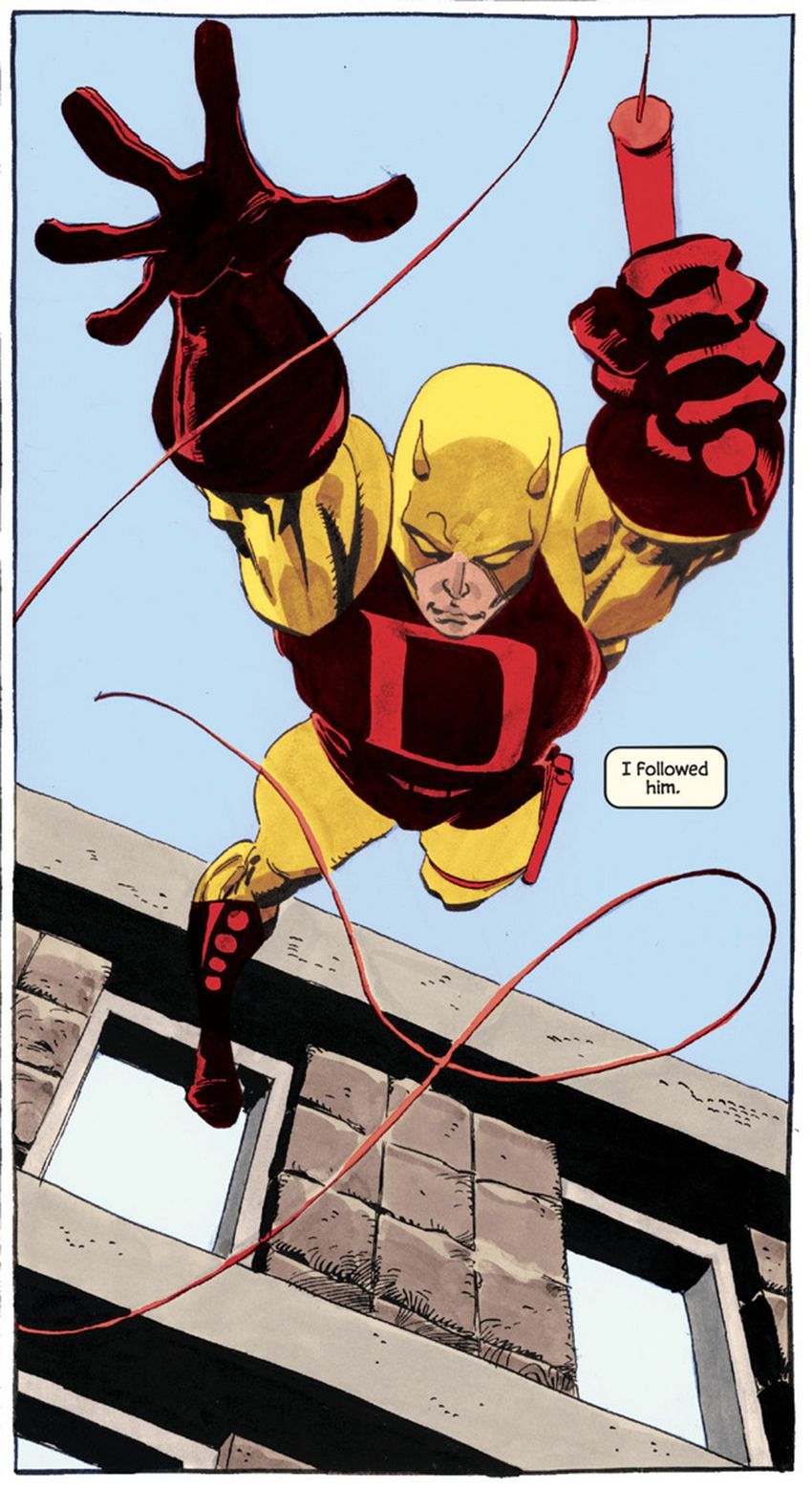
Pedro Franz
Is a Brazilian comic book artist, who was born in Santa Catarina and has a degree in design.
He has been publishing several comic books and participating in exhibitions in Brazil and abroad. As an illustrator, he has published works several magazines and books, and regularly collaborates with the Piauí magazine. As a graphic designer, he is a contributor to the Par (Ent) Esis platform. He has comics translated and published in English and Spanish, and has good international recognition, thanks to his publications.
But what is most impressive in Pedro's art, perhaps is his intensive use of colors. Mixing various shades of different colors, mixing different compositions. In addition to sometimes using characters from pop culture, with his elaborate style.
Despite liking traditional comics, he has always published and worked for national publishers, often with authorial works.
Perhaps his best known work, which was even published in the United States is the comic “Suburbia”.
Suburbia tells the story of Conceição, a girls daughter of enslaved rural workers, who flees to Rio de Janeiro in the early 1990s. In the city, Conceição begins to work as a cleaner and to get involved in the world of funk, slums and poverty.
His drawings are extremely surreal, not exactly following a traditional way of making comics, with several images spread across the page, with different shapes and sizes, with extremely strong colors, mainly valuing blue, purple, yellow and red, as his main colors.
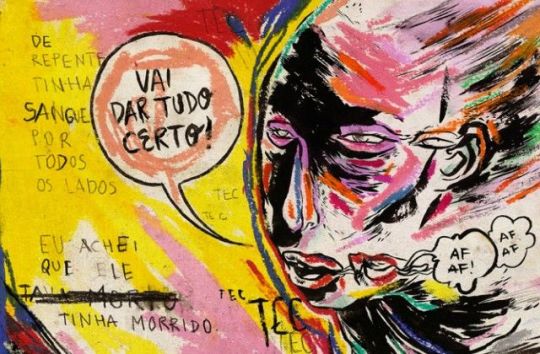
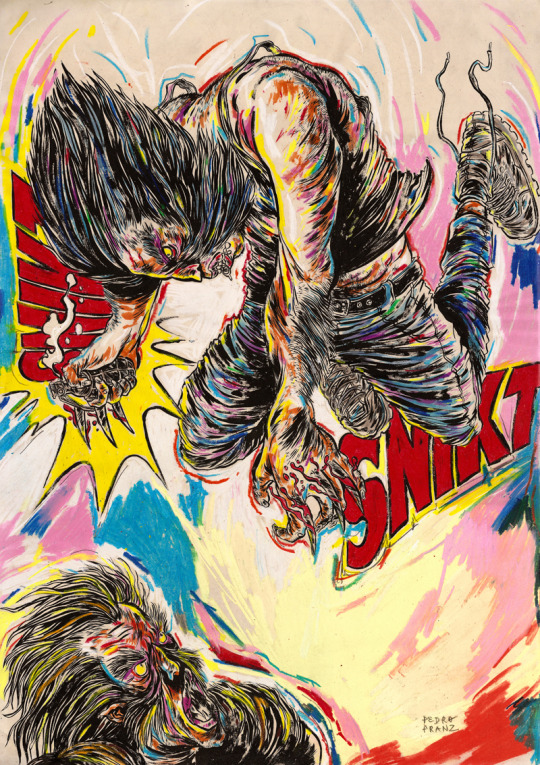
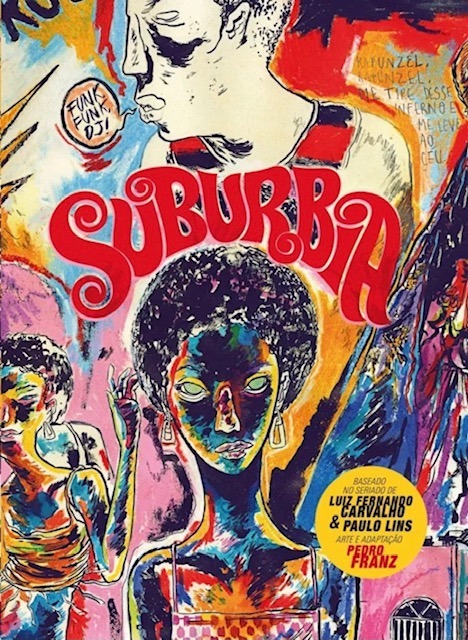

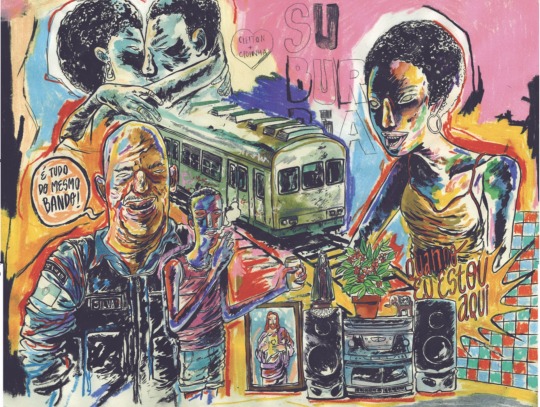
Richard Corben
Richard Corben was one of the contributors of elevating the comics to the category of Art, and of its unparalleled style of great influence among many current artists.
Richard Vance Corben was born in Missouri, United States on October 1940, in a family of farmers in the middle west ( where he started reading comics), and lived in Kansas City. There he studied Fine Arts, got married, had a girl and started working in local cinematography animation company. At the same time, he started to create and publish some underground fanzines. From the begging it was clear that he was interested in science fiction, eroticism, and total rejection of institutions ( the Army, the Church, etc), mixed with a lot of humor.
At a young age, Corben was an aficionado of bodybuilding, just like everyone who was interested in a persons aesthetics. The first character that he created, was Rowlf, a dog who took on a human form. In the beginning of the 1970s he amplified his work ( and his fame) in some underground magazines. And in 1971 he started working for the Heavy Metal publisher where he created one of his most famous characters, Den a large muscular man, who was always naked, and always after some adventure.
Corben has a very particular style, with unsettling mixture of caricatured, often satirical grotesque and intense,convincing realism. Never before had such wildly cartoonish worlds proved so convincing.
Also he can handle an exponentially higher standard because of his ability to use colour to show the effect of light on whatever he’s depicting. The way that he mixes light and colors in certain panels to differentiate those elements from each other, is something to admire.
Corben worked in a few mainstream comics, he always preferred to work with authorial works or working in specific themes like fantasy and science fiction comics and not so much on superheroes.
But probably the most famous mainstream comic that ever worked was the character Hellboy, along with writer Mike Mignola.
Hellboy is a series of comics that has a lot of mysticism, Norse mythology, horror and monsters. Something Corben certainly agreed to do, without thinking twice.
Richard Corben is one of my favorite artists, with a style that is perhaps not as realistic as an Alex Ross for example, but the humor and beauty that he puts in his characters is very unique.
Corben died on December 2, 2020, leaving a great legacy, for the world of comics and arts, with a very unique style and extremely stunning worlds.
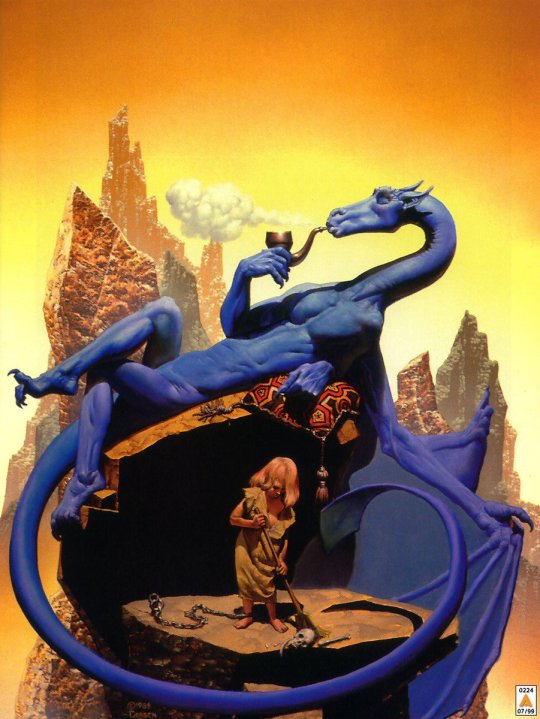
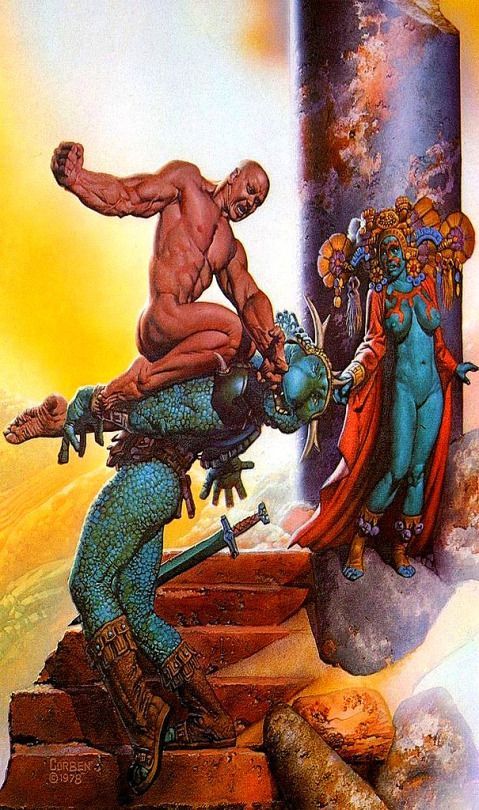
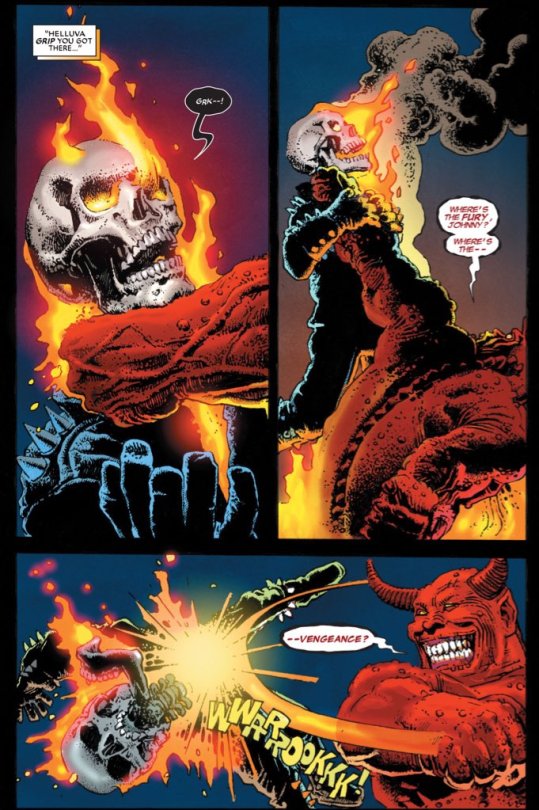
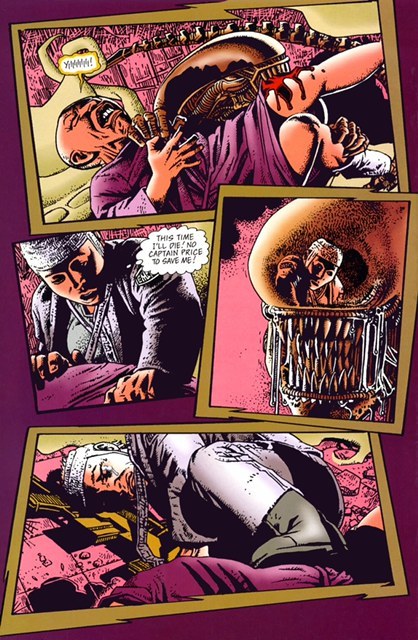
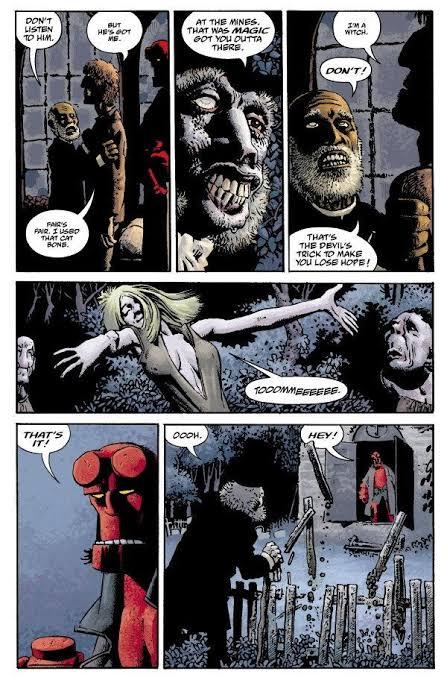
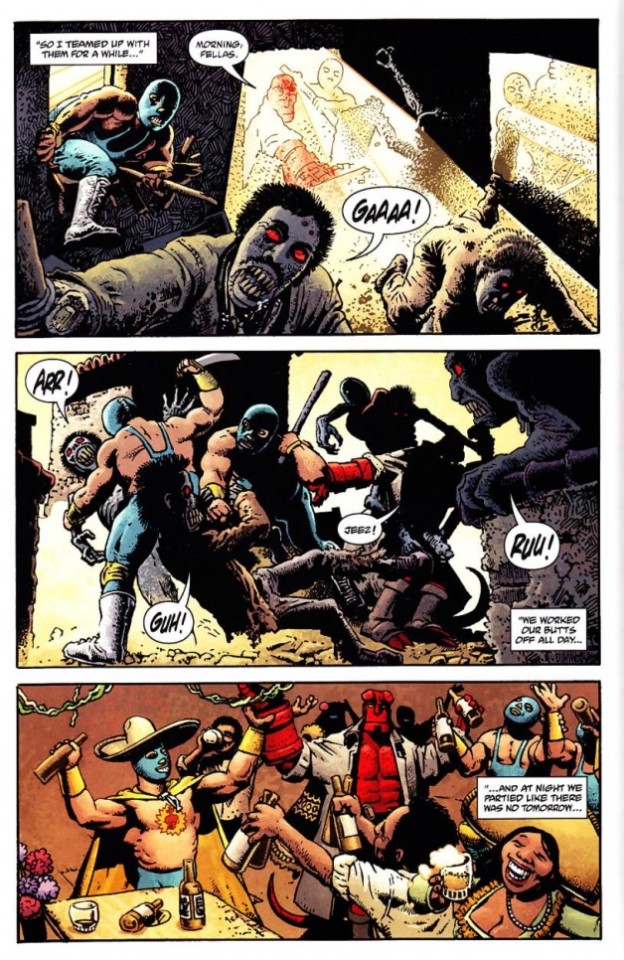
Charlie Allard
Charlie Adlard is a British comic book artist, who have worked on the comic industry for over 25 years. He spent the majority of his time since 2003 working in The Walking Dead along side with writer Robert Kirkman , until the last issue on 2019 He started reading comics when he was very young, and he said that he was very lucky to have influences of American comics and the more high art, such as Asterix and Tin Tin. He was fascinated by European comic books artists like Moebius, Alberto Uderzo and Herge. He started his career as many British artists and writers, working on 2000 AD, with characters such as Judge Dredd, Armitage and eventually Savage. In the United States he started working with the X Files, Astronauts in trouble, and of course The Walking Dead. Adlard started in The Walking Dead from issue 7, and brought a slightly different style, from the previous artist. Adlard's art is very cartoonish, but the universe of The Walking Dead still doesn't get silly because of it. Quite the opposite, the dirt and rot that Adlerd puts on his characters and the world, only sustains what a horrible world it is to live in. Many readers complain about Adlard's style, being very simple, that his characters are very similar, and sometimes it is difficult to identify them. But I believe that although his style does not vary much, when it comes time to show a horde of zombies, a devastated city, people feeling despair, and extremely disturbing scenes, Adlard manages to excel. Adlard's main tool is ink. All The Walking Dead magazines are in black and white, and he manages to give a lot of depth to the scenarios and characters using only a few ink stains. Today Adlard is doing some comics, mainly for DC, but says that he does not intend to work with Kirkman and zombies again, because he wants to explore other themes, and to innovate his drawing skills.
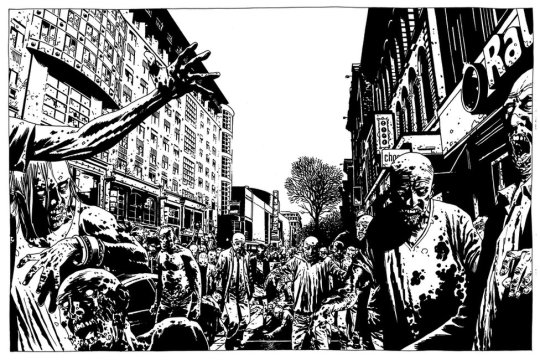
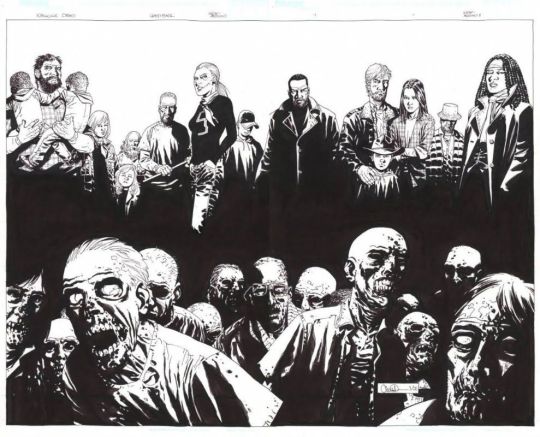
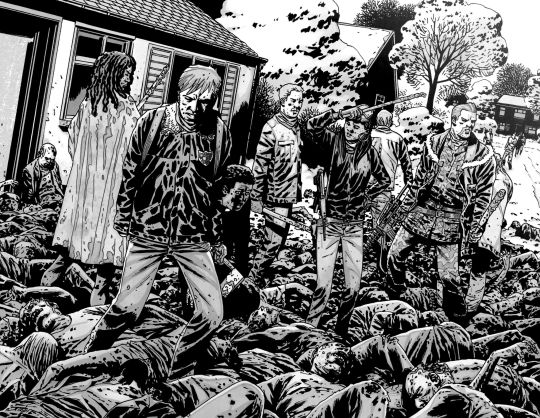
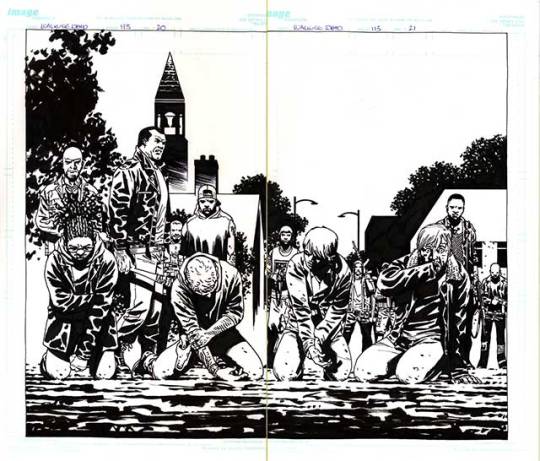
Zaha Hadid
Zaha Hadid was one of the most important and well known figures in contemporary architecture and design. With a singular trajectory, marked by a versatile, bold and out of the box style, she was the first woman to receive Pritzker Prize for architecture and was also the only female representative honored by the Royal Institute of British Architects with a golden medal. Zaha Hadid was born in Iraq, more precisely in the city of Halloween, in Bagdá, in the year 1950. Her family was of high class, her father being an important politician and her mother an artist. Still young, she traveled and studied in other places of the world, like London and Switzerland, but it was in her native land the she got her first formation, when she graduated in mathematics. At the age of 22, in 1972, she enrolled in one of the most famous independent schools of architecture in London, and there she gave the starting point to her career by studying and creating an important connection with the Dutch architect Rem Koolhaas, a figure that encouraged her and opened the doors for opportunities. Later in the 1980s, Zaha Hadid decided to open her own office. This, Zaha Hadid Architects was born, which made her name and talent recognized worldwide. Known for her works with futuristic lines, clean and pure forms, as well as the fragmentation of architectural design. Her projects and discussions raise issues that put architecture and its future to the test. This is because the architect seeks in her works to interrelate design, architecture and urbanism. I knew Hadid and some of her works, but it was the recommendation of my teacher Lauren, that I should look for this architect. As my project takes place in the future, she recommended that I look at some works by Zaha Hadid to get inspiration when creating the scenario for the comic. I find it very interesting how her works have this futuristic aesthetic , because it reminds me of science fiction films like Blade Runner with those skyscrapers and buildings with different shapes and sizes that are extremely imaginative that could only exist in films. With unique works and projects, famous for their exuberance, futuristic elements, curves, non linear shapes, distortions and fragmentations, Hadid inspired and generated fascination both for her constructions around the world.




Syd Mead
Syd Mead was a designer, best known for working on films such as Aliens, Blade Runner, Tron and Star trek. Mead was born in Minnesota, United States, on July of 1933, but five years later he moved to a second house in the western of United States prior to graduating from High School in Colorado in 1951. Some years later, he did the Art Center School in Los Angeles, where he graduated with great distinction in 1959. He was immediately recruited by the Ford Motor Company. At Ford he worked in the advanced styling department, creating futuristic concept car designs. But his imagination went beyond cars and he began to imagine clothes, helmets, buildings and scenery from hyper advanced civilization. After Ford, he also worked in other big companies like Chrysler, Sony and Phillips. After that he started migrating to the concept art world of movies. Mead is really important for generation of writers of science fiction, because many of them were influenced by Mead’s colorful paintings. Mead never wrote a novel or short story. He imagined the future in his mind and turned that imagination into illustrations. In 1979 he designed the extraterrestrial spaceship for the first film “Star Trek” in the cinema. Ridley Scott called Mead to design the buildings and flying cars of the futuristic Los Angeles “Blade Runner” in 1982. In 1986 he was hired to design the space station and vehicles of the movie Aliens directed by James Cameron. Almost at the same time, the designer created the electronic world of “Tron” for Disney studios. The same ones who hired him in 2014 to design the futuristic city of “Tomorrowland”. Mead died in 2019 after three years of lymphoma, he was 86 years old. He was a great influence for many designers and science fiction writers and illustrators, due for his creative worlds and automobiles , Elon Musk quotes Mead as one of his major influences, on visions of the automotive future and design in general.
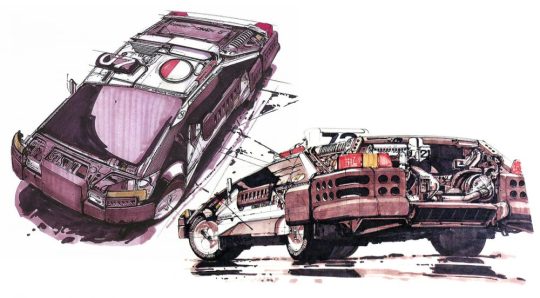

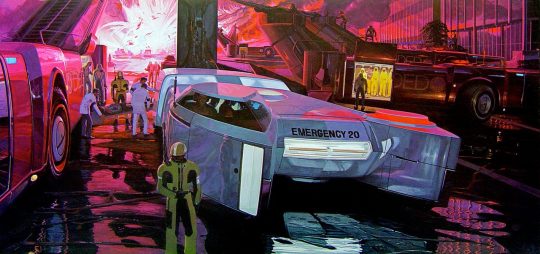


Transmetropolitan by Warren Ellis and Darick Robertson
Transmetropolitan is a comic written by the British writer Warren Ellis and the American illustrator Darick Robertson, published by the Vertigo label, and falls within the cyberpunk genre, and the problems that rampant technology will cause us.
Throughout the 60 issues of Transmetropolitan, Ellis and Robertson build a chaotic and brilliantly alive future, presenting a sci-fi society with a peculiar mix of elements of cyberpunk, political dystopias, bioengineering and transhumanism, sexuality, economics and much more.
In a dystopia, in a not so distant future, the journalist Spider Jerusalem is isolated for fiver years in a hut in the forest, but he has to return to the city to earn some money.
Throughout the comic, amid a nihilistic aura that humanity has no salvation, the author- Warren Ellis - criticizes the consumerism and futility. The illustrations, of Darick Robertson, is full of excesses as the environment should be, a brand of the style of the 1990s.
The search for the truth is the central theme of this work, and in the midst of all this we found ourselves in a investigative odyssey that involves the lowest scum of that society ( thieves, murderers and rapists) until reaches the highest of the scum ( the presidency).
This background allows the work to touch on the most profound social themes, and without fear of saying what needs to be criticized, this is where Transmetropolitan shines, and provoke deep reflections on issues such as racism, the influence of media, the power of religions, the education, and many other themes.
In short, Transmetropolitan dissects and criticizes everything, it points out the flaws, the lies and the hypocrisy of each one. It’s a study about the problems of democratic society in the 21th century.
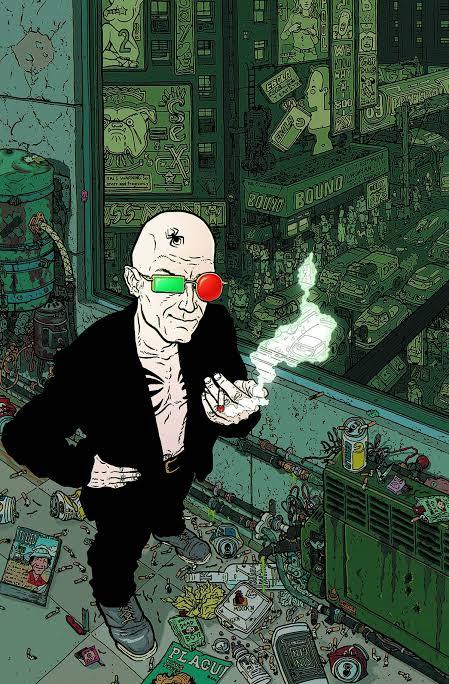
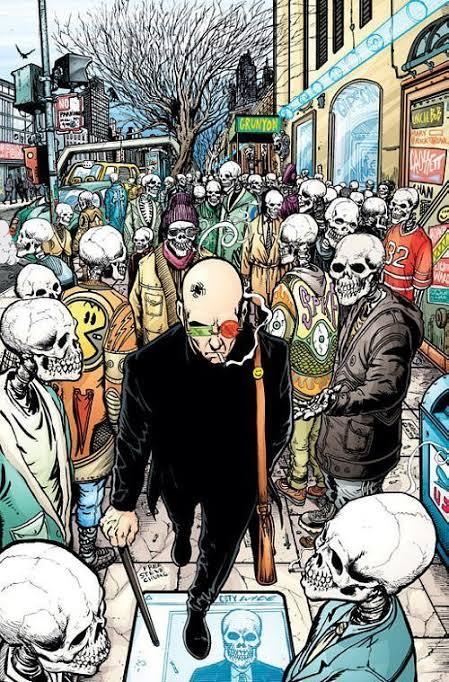
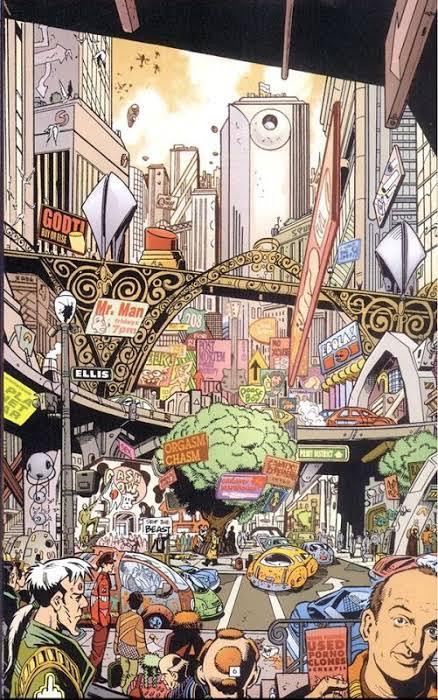
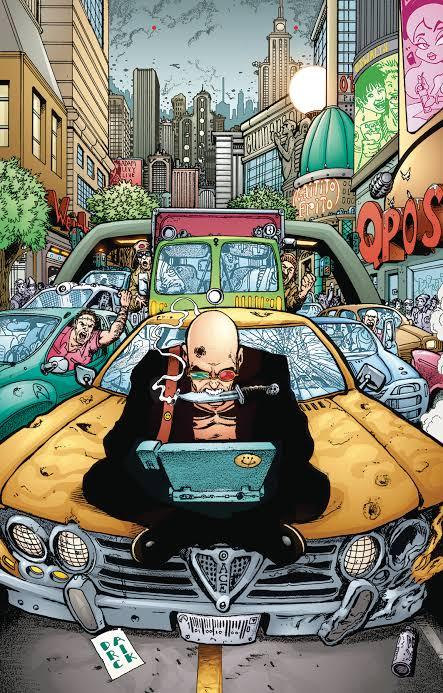
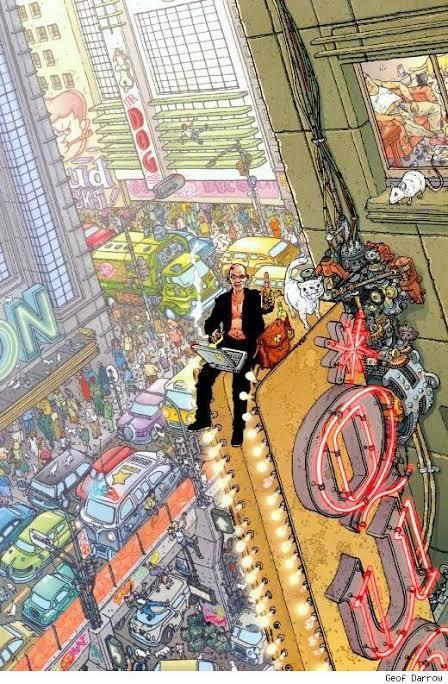
Jon Mcnaught
Jon Mcnaught was born in 1985, London, England. He work with drawing comics, and work as an illustrator, printmaker and lecturer. After spending several years on the Falkland Islands during his childhood, which will inspire his second book, Pebble island. The book pass years after the war, where he tries to recreate his childhood, with aspects of his curiosity, when he was exploring abandon bunkers, where it was just part of landscape, or somewhere where he could play. His work has essentially been landscape print-making (often situated in the city), but with quite simple intention of capturing the sense of space, light, time etc. His work is mostly about that, places that he was interested in depicting, and trying to reproduce the visual. He want the characters to feel like elements of a landscape or an environment ( he preferes to focus more on the background, than the characters itself). But usually he uses figures and postures to suggest expressions rather than close ups showing facial features. What I like about Mcnaught's work is that they are simple designs, but the colors are very vivid. The way he constructs the scenarios is very invective, because it doesn’t need to be extremely detailed, he just needs a few lines to show what he is talking about.
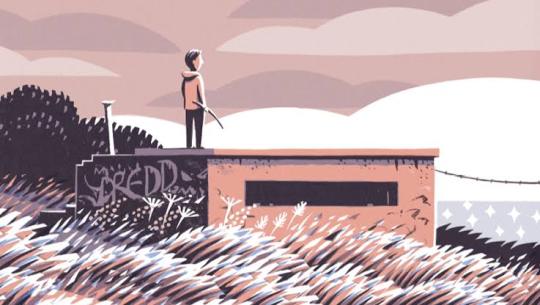
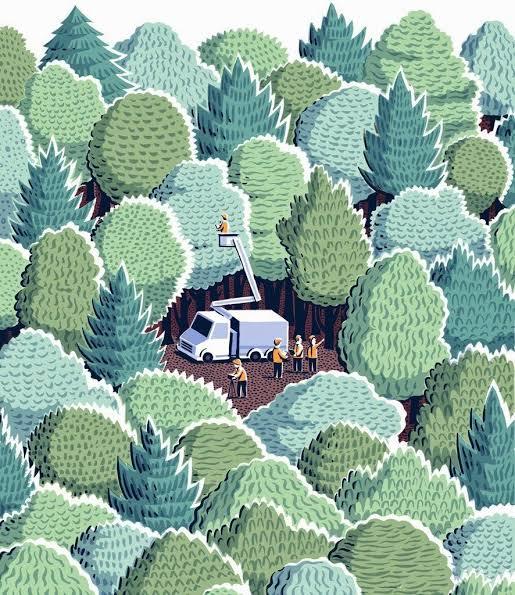

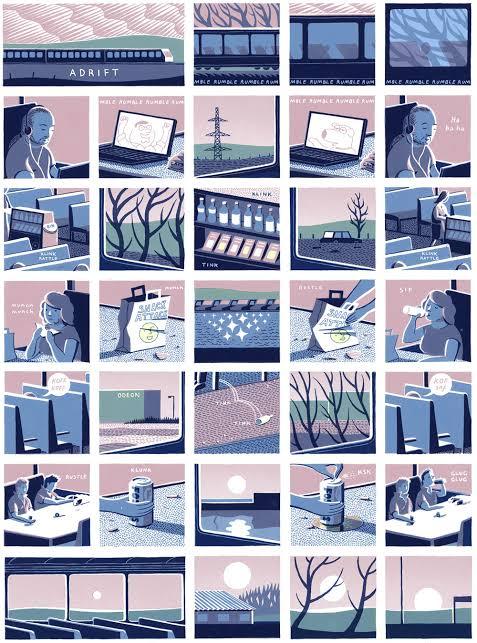
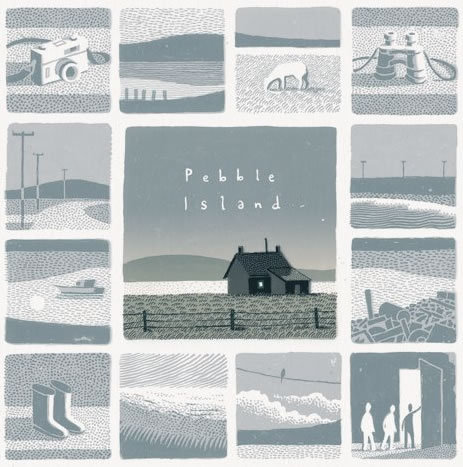
13 notes
·
View notes
Note
Janicza is a very good friend as in besties with Jeremy O'Harris. You might be on to something in the reading. JOH is having arguements with people on social media right now. I am sure P is aware of that and Janicza too. Maybe they both take different sides and that affects their friendship or work relationship. We all know P does not like fights. Janicza maybe neither but she might choose for JOH and P doesn't. I can be wrong though. What do you think? Something in the cards?

Hello! Thanks for letting me know of this problem with JOH on social media, I didn't know it was happening. Well, I asked what the cards could tell me on this possibility of a disagreement between the two concerning Jeremy and I pulled the 6 of Swords reversed. I didn't research what he is fighting about, but this card didn't really give me the impression it is about him. Reversed, the 6 of Swords is pointing to someone (it could be one or both) struggling to leave the past behind. Someone went through turbulent times and they are not letting go yet. There is transformation ahead, changes to be made, but this person is procrastinating it in a way, they are hesitating and still not moving on. When I asked if the cards could show me more, I pulled the Page of Pentacles. Now this Page is a very grounded one, he's quieter, he keeps it to himself, he can bring some good energies to any project you have in mind, but his personality is very closed and introspective. That reminded me of the holding back signals I was getting in the beginning, someone is not ready to move on from something and ends up closing off somehow and going way too practical.

Then, I asked if the mixed signals could have something to do with Janicza's divorce or Pedro not wanting to be a rebound like the anon asked me. I pulled The Devil. Now this card is interesting. It's not always related to that, but since we are asking about possible sparks between them and holding back, this card seems to be pointing to the existence of some serious sexual energy in there. The Devil is about humanity and what makes someone human, human desires. So there could be a lot of things in question, vices, lust, material ambitions, greed, even narcissism, but also sexual energy. I asked again and I pulled the 5 of Pentacles reversed. When reversed, this card actually points to some letting go and getting over some troubling times, including finantially, But apparently this person is taking the way of The Devil to leave the bad times behind, everything they went through, and to... well, rebound. This card is also pointing to some kind of offer being made, but we have someone who can only offer the traits of the Devil.

Could we be talking about a sexual connection here and someone going the sexual route to let go of something, possibly Janicza's divorce?

I then asked my Oracle of Delphi about the reason why there could be conflict between them, and I pulled at first Work in Vain. This card is actually a warning, in any situation, work, love, friendship, that your efforts will be fruitless, nothing good will come out of this relationship, whatever that is, and work will be in vain. When I asked for clarification, I pulled the Hell card, which only makes things worse, as it's about fighting, conflict, disharmony, misunderstandings, disappointment. When I asked if that had anything to do with what the anon asked about, Janicza's divorce and Pedro not wanting to be a rebound, and I pulled The Awakening, then the Mother, then Sincerity. The first card is about an awakening, of any kind, but specially spiritual, like seeing something. The Mother is about a female who becomes really protective and sweet and nurturing of someone. Sincerity is about a clear communication, about being honest. Honestly, this seems like there was some insane sexual energy between them but Janicza (or both) decided to go the protective and caring route, like a Mother.

This onlye became more clear when I used my Energy Oracle cards and pulled Caring Connections, Archangel Uriel and Ying/Yang. This first card is pointing to connections of any kind being formed, they could be a friendship or work partnership but it could also mean some romantic feelings being developed. The second card is about a great time to connect with your own spirituality and you will find all the answers you need, which leads us to the Yin cicle, as the card is upright. It's about a moment where most of the action is happening below the surface, there's a lot of intuition flowing but it actually brings you to look within yourself, it's a passive and receptive energy. So again, I would really say there could have been some "human", sexual energies in this relationship, but one or both chose or will choose another path. Could that lead to disagreements? I don't know, but the disagreements could lead to the holding back, it could be the opposite.

As you can see, their readings are still mixed. We'll have to wait and see how this goes. Sorry for the long reading, I tried to gather as much info as I could from the Oracles!
1 note
·
View note
Text
Bogha-frois Conversations: Will Hammond
Early this year during Glasgow’s Celtic Connections Festival I had the pleasure of joining a host of incredible LGBT+ artists for a performance and a panel around the theme of Bogha-frois: LGBT+ Voices in Folk. A brainchild of Pedro Cameron (Man of the Minch), Bogha-frois began as a workshop at the Scottish Storytelling Centre and takes its name from the Gaelic word for “rainbow.” The energy around Bogha-frois has enacted a metamorphosis - far beyond a standalone workshop, panel, or critically-acclaimed gig, Bogha-frois is a movement celebrating gender and sexual diversity within traditional and folk music, song, and dance in Scotland. Following the events in Glasgow, I wanted to continue these conversations and proposed a series of monthly blog posts. It’s hope this series will be a place for dialogue around the intersections of traditional arts, identity, and each artists’ path as a LGBT+ person. This month’s Bogha-frois conversationalist is percussionist Will Hammond!

Tell me a story... what was a moment when you felt both your identity as a traditional musician and your identity as a LGBTQIA+ person were in focus? (1)
Obviously the Bogha-frois workshops and concert were a pretty decisive event for this. During those days it felt most apparent and explicitly like "this is what this is about, this is inextricably part of who we are and what we're doing", which did feel like the first time outside of maybe being at pride or a protest that I've felt quite so "out" and among similar people, and the only time where the musician part of my identity has been equally in focus. I'd had a few conversations with other queer musicians about navigating the world the ways we do prior to those workshops, and each time my thoughts of "I'm sure I'm not the only person" became "oh, wow there are other people experiencing these things!" So, to have so many people gathered for the workshops and concert laid out this confirmation on a scale that was very affirming.
How do you identify? What are the pronouns, descriptors or other words you like to use, if any, to describe yourself in regard to your LGBTQIA+ status.
I'm bisexual, in that I am capable of being attracted to people of more than one gender. My own gender is a total mess and I use he/him pronouns but they/them pronouns are fine, kind of whatever, really. Genderfluid and nonbinary are terms that fit; I don't think I really know what I "identify" as on an that instinctive visceral level. If I introspect on it, I always come out thinking "I don't know what feeling like a man or a woman or anything else feels like, I just feel a bit unpleasant." I find personally trans/cis is a pretty quirky binary in itself. "Do you agree with the doctor who said 'it's a boy' when you were born?", I mean, I guess, yeah sometimes but also sometimes not, right?

(percussionist Will Hammond, photo by Amelia Read)
Talk about your perceptions of LGBTQIA+ identity (both yours and others) within your experience playing traditional music in Scotland.
When I've played in Scotland my own and others' identities have either gone unmentioned and un-talked about or they've been the focus of the event- referring to the Bogha-frois concert, so my experience has either been extremely welcoming and accepting or I haven't had to think about it. Being English and mostly working in England, I don't expect my experiences of this in Scotland to be comprehensive or universal for Scottish musicians.
In what ways do you feel your identity as a LGBTQIA+ person and a traditional musician intersect, overlap, engage?
I am fairly open to talking about my queerness with other people I play music with, and most of these people, if they are not themselves lgbtq in some ways, have usually demonstrated that I can trust them about it. Ever since I first read about it I've enjoyed exploring the idea of music as a verb rather than a noun. I also like the line of thought leading off about how a musician who is just walking down the street, or making a cup of coffee, or trying to get to sleep, is still a musician. Even if what they are doing in those moments is not musicking, their musician-ness has affected how they experience and interact with the world. I think, for myself, I can draw definite parallels to my queerness in here. How applicable that is for other people is totally up to them, of course. At the moment I have "trans rights are human rights" written in block capitals down the side of one of my main instruments, and I don't exactly present as the most obviously straight person in the world, so I suppose I'm not trying particularly hard to keep my queerness and my musician-ness separate.
Talk about your experience connecting with other LGBTQIA+ folks both inside and outside the traditional arts.
I have worked a couple of times with other lgbtq artists in the trad scene and beyond, but prior to the Bogha-frois workshops it was never a specific condition or factor of us working together. It would emerge over the course of us practicing usually, or I already knew about the other(s) going in and would tell them about myself.
View this post on Instagram
A post shared by The Cusp (@thecuspmusic) on Apr 8, 2019 at 9:08am PDT
(Will’s band The Cusp with fiddler Imogen Bose-Ward and harpist Ada Francis)
If you’re comfortable sharing, talk about any incidents of homophobia or transphobia that you’ve witnessed both inside and outside the traditional arts.
In a performance context I haven't experienced any myself, which has been nice, but on at least two occasions during practices with other musicians, after coming out to them as bi they have immediately asked me about how open my partner and I are to threesomes. Outside of music, just in the last couple of years I've been called slurs in shops multiple times, in the loos at Newcastle railway station a man told me that I'm in the wrong queue and should be in the ladies'. I've been given "that look" by several men for being in public with other queer people. Once, someone I used to work for grabbed my wrist and tried to scrub off my nail varnish with her hand as if she thought that would work and was an acceptable way to treat another adult. I've certainly not had as hard a time as some people I know, but I have plenty of my own evidence for how marriage equality certainly didn't end homophobia, let alone transphobia.
How do you see the traditional arts changing in regard to LGBTQIA+ people? What are the further changes you would like to see?
I'm stuck with being a convert, a backslider, and a reformist with respect to trad music. I didn't get into folk until I was introduced by a friend. I was maybe 17, by which time I'd already been playing music in some form or other for about 9 years. Then playing, listening to, learning about, trad things became a focus until I was maybe 21, when I learned a bit more about abstract expressionism and free improvisation and started enjoying the weirder sides of trad playing more and the "regular" playing a bit less. It was partly burnout from having finished university but getting outside of the folk bubble having spent a short time intensely involved in it was definitely a breath of fresh air. The final project of my studies was a summary of this process in a way, looking at how genres are constructed in the modern age and how occupying the spaces between them can result in some interesting things. I'm fascinated in the ability to use this music to tell stories and preserve memories. I'm also aware of the parallel consequence that allows this music to distort realities and, through entirely benign inaction, forget. I hesitate to speak for the Scottish traditions as I'm only an occasional visitor, and in the words of Leon Rosselson, I'm not suggesting any sort of plot. However, there have been times I find it difficult to look at the amount of lighthearted crossdressing, not so lighthearted crossdressing, "shapeshifting", "enchantment", utter disinterest in marriage, and portrayals of homosocial relationships in traditional songs and not feel concern when these things are overlooked. Even more so when they are explained away in a manner that preserves the current cisheteropatriarchy like it's something that's always been there. The places this music comes from are important, and preserving it and celebrating it definitely is a worthy pursuit. It then follows that to gloss over the parts that don't fit our construction of history is partly what leads us to situations where it takes a whole room of queer musicians simply pointing out that we exist, maybe for ourselves as much as for an audience, to get people thinking about it. As such, and though I recognise that it's difficult to apply current terminology around sexuality and gender to historical time periods, "The Folk", whoever they were, ought to be perceived as less monolithically heterosexual and gender conforming. Applying this way of thinking and looking can go forwards as much as backwards, and achieving a greater diversity of voices in the trad scene is an important goal, I think.
First Footing is a collaboration between dancer and dance researcher Nic Gareiss, the Traditional Dance Forum of Scotland, University of Edinburgh Moray House School of Education, and the School of Scottish Studies with support from Creative Scotland. For engagement opportunities check out the First Footing website.
(1) Following methodology developed by Fiona Buckland in her book Impossible Dance: Club Culture and Queer World-making, I began each conversation asking artists to tell me a story. This, Buckland reminds us, redistributes significance to the voice of the artist, rather than the anthropologist/researcher/interviewer. In Buckland’s words, “the meanings they made from the practices are more crucial than whatever meaning I impose with the theoretical tools in my standard issue doctoral utility belt.” (Buckland 2002, p. 11) This feels incredibly important when collaborating with folks whose voices have so often been underheard or marginalized.
#bogha-frois#rainbow#will hammond#therewillbevibes#queer#bi#bisexual#trans#non binary#enby#nb#traditional music#percussion#newcastle#newcastle on tyne#Fiona Buckland#queer theory#conversations#LGBTQ#LGBTQIA+
1 note
·
View note
Text
Legendary 1888 Cocobola Surfaces at Sedwick Auction 27
By Tom Michael
With Daniel Frank Sedwick LLC Treasure auctions, you can always expect to find a wonderful selection of silver cobs; those irregular, chunky silver coins produced so quickly and in such quantity through the Spanish mints in the New World. While many date, assayer, and mint denomination combinations are common, there are many others that are extremely scarce and still more being discovered as the years go by. I always take a look at the DFS Treasure Auctions to see what’s new in the cob market and to peruse the odd shipwreck finds, hoping to expand my knowledge.
With DFS Treasure Auction 27, it was not until the last week in May that I was reminded, by a fun CoinWeek podcast interview with Dan Sedwick, conducted by Charles Morgan, that the sale would be closing at the end of the week as I write this. As I worked on a project I had the podcast running in the background and was moving right along until I heard Dan say “Cocobola.” Being a fan of Colombian numismatics, this caught my attention.
The “Cocobola” Cincuenta centavos struck at Bogota in 1888 is one of the great rarities in the Colombian half dollar series. Only five are known and only two of them have surfaced at auction to the best of my knowledge. (All images courtesy Daniel Frank Sedwick, LLC.)
The Cincuenta centavos known as the “Cocobola” was struck for circulation in 1887. The recorded mintage is quite high, but the coin was extremely unpopular due to the continued reduction in fineness to 50 percent or .500 fine, which had been instituted by Colombian President Rafael Nunez in 1885. To top that off, a new bust of Liberty had been designed for this 50 centavos piece, which was modeled on the likeness of Nunez’s wife, First Lady Soledad Roman. Soledad was as politically active and influential as her husband and the two of them had been moving Colombia in the direction of a very authoritarian nation as a response to a near chaotic, yet freedom enhancing liberal period.
Colombia has a rich and confusing political history, which is truly a marvel for historians to study. For purposes of present explanation, suffice it to say that in 1863 following a two year Civil War, the liberal winners renamed the country Estados Unidos de Colombia (United States of Colombia) and created the Constitution of Rionegro, which brought the citizens of the country a great deal of freedom and the states plenty of autonomy.
By 1876 these freedoms and independent rule had begun to create problems at the federal level and more conservative politicians repealed the Constitution of Rionegro. They renamed the government the Republic of Colombia since separate state rule had been a big part of the problem for the federal government, and wrote a new constitution in 1886 to back up this federal control. The President became a Congressionally elected position and his term expanded from two years to six years. State Presidents became Department Governors and once their terms were served, the Federal President appointed new people. Those appointed Governors, in turn, appointed mayors throughout their departments, except for Bogota’s Mayor, who was appointed by the Federal president. Elections by the public were basically limited to department assemblies and municipal councils. In effect, the countries’ direction fell under the control of a limited group of people and stayed that way for a very long time.
So back to our coin, the Cincuenta centavos of 1887; why was it referred to as “Cocobola”?
During the long conservative period following those 23 years of expanded freedoms there were folks who fought to regain what they had lost. In 1885 Colombia found itself in Civil War, with rebels led by Pedro Prestan clashing with Colombian federal troops in the department of Panama within the city of Colon. An American delivery of arms was held up in port, Prestan got mad and arrested some Americans, negotiations ensued, Colombian troops took the opportunity to move in and in the end Colon burned and the American garrison pulled back as there was no hope in saving much of any foreign-owned property that they were there to protect. Afterwards, United States troops returned and occupied both Colon and Panama cities and Prestan was hanged for having given the orders to burn Colon.
It’s rather difficult to determine exactly who was responsible for the Burning of Colon and Prestan was eventually absolved of having given the order, though his life had already been forfeited. At the time however, it was believed that, as the DFS Auction 27 lot description explains, “Prestán’s revolt, ostensibly opposing the involvement of the United States of America in the conflict (the US’s interest, of course, being the construction of a canal connecting the Pacific Ocean to the Caribbean Sea), employed two Caribbean liberals, the Haitian Antoine Pautricelli and the Jamaican George Davis, to burn down the city of Colon. George Davis, later hanged for this crime, was better known as “Cocobolo.’”
The French had begun work on a canal through Panama in 1881 and all countries, particularly the United States, were watching closely. George Davis was in Panama to work on the Canal, having been hired by the Kingston, Jamaica, agent of the Canal Company, a Mr. Gadpaille. Davis came in on the Royal Mail Company’s steamship, the Dee. He was a big guy, and a big drinker, as many of the Canal workers were.
At some point Davis and Pautricelli had left canal work and joined Prestan’s rebels as they were there in Colon with him. However, after Prestan’s retreat, Davis and Pautricelli were captured in the city by Lieutenant Robert Doyle of the U.S. Navy, arrested, court-martialed, and hung. While Pautricelli denied guilt in a letter to Prestan and in a gallows platform speech, Davis simply said “adios” before being hung.
Afterwards, Davis’s nickname of “Cocobolo” was used in Colombia as a derogatory term, meaning “no good.” So when the public realized that the 1887 Cincuenta centavos, a coin already known to be of limited silver content, had a debased piece of currency, and featured their disliked First Lady, they gave it the feminine gender nickname “Cocobola.”
But knowing the history of this intriguing coin’s nickname does not complete the story. As I tuned back into the podcast with Daniel Sedwick, I realized he and Charles Morgan were talking about an 1888 Cincuenta centavos of the Cocobola style. While the 1887 date of this type has always been a difficult coin to find, presumably because of its unpopularity at the time of circulation, the 1888 issue is almost unobtainable. Production for the 1888 dates began, but was halted due to public distaste for the type. A few of the 1888 dates were released and remained in circulation, while the rest were recalled.
The standard reference for Colombian half dollars, written by Jorge Emilio Restrepo and published in volumes over time until it was combined into a single edition in 2006, indicates that only five examples of the 1888 Cocobola are known to exist. This particular example is the plate coin from Restrepo’s book.
I had never seen any of the 1888 Cocobola types on the market, but while researching for this article I did find an AU Detail, but cleaned example, had sold at the Stack’s Bowers Galleries ANA Auction in August of 2018. That example sold for $22,000 and it was the first auction appearance I could locate.
The Restrepo plate coin auctioned in this Daniel Frank Sedwick Auction 27 in May 2020 was graded VF-30 and realized $10,000. I will be shocked if another example surfaces over the next 10 years, but who knows.
Overall, the DFS Auction 27 was a very successful sale, with many rarities to offer. Connor Falk let me know that they had many more bidders than ever before and achieved total sales over $2.4 million. That’s fantastic news and a great sign for the Latin American area of the numismatic market.
So now, in addition to cobs and treasure coins, I will need to be closely watching Daniel Frank Sedwick sales for a new specialty; rare Colombian coins. In fact, while looking through Auction 27 I noticed a few other Colombian coins that should be mentioned here.
The finest known example of the extremely rare Medio peso of 1868 struck at Medellin went to a new home and will probably remain there for a very long time.
There were several extremely tough coins from the Restrepo half dollar series in the sale. One standout was the Medellin Medio peso of 1868, which is a very rare single date type of the Estados Unidos de Colombia period. You don’t see this coin often and the auction catalog description reminds us that only six are known. Most known examples are well worn, but this piece is PCGS graded MS-62. It’s the only mint state example and was the Restrepo plate coin. The final hammer price was $32,500, so $38,675 with the juice. Similar to the Cocobola coin, you have to go back to the Stack’s Bowers Galleries ANA sale in 2018 to find a comparable piece, the second best example, a PCGS graded AU-50 that sold for $17,000. I could find no other examples at auction.
Many of the other Colombian highlights from this sale are also Restrepo plate coins and of the highest quality. I’ll rattle them off here for reference. The Popayan 5 decimos KM-153.6 is a very rare type with two extremely rare dates in its run. The 1880 strike, of two believed to exist, sold for $3,250. The 1886 dated varieties of Colombian 5 decimos are extensive and one of the rarest has a curl of hair on top of the Liberty bust and lacks stars or dots at the sides of the Medellin mint name. It catalogs as a Restrepo 304.1 and KM-164.2. The Restrepo plate coin sold in DFS Auction 27 for $1,700, which is a fine bargain for its astute new owner. Not a rare type, but a real grade rarity, a little Medellin half decimo of 1868, recognized as the finest known example at PCGS MS-64, sold for a stunning $950 to a collector of high-quality coins. Another connoisseur grabbed the Bogota half decimo of 1871, also finest known of its type grading PCGS MS-63 for $475 at closing hammer. Restrepo’s plate coin for his 401.1 and KM-167, the unique Medellin 1888 5 decimos with elongated head and slightly shorter hair, sold for $2,600 or just over $3,000 with the juice. That is a great bargain for a coin that will be the centerpiece of any Colombian half dollar collection. Finally, the plate coin for Restrepo 404.1 or KM-168, a Medellin 5 decimos with large bust and stars and leaves in the legend sold for $5,500, also a great bargain, as I have never noticed this coin selling at auction or even been able to get an image for the Standard Catalog of many years of looking. One final note regarding all the varieties cataloged by Restrepo for the half dollar series is offered in the DFS lot description, “Restrepo’s theory as to why there was so much variation in design in the Medellin 5 decimos of 1887-9 is that “the engraver was sent to jail and nobody else had a good understanding of die production procedures.”
A stunning MS-65 example of one of the three issued dates of colonial Pillar 8-reales struck at the Nuevo Reino Mint in what is now Bogota, Colombia. This is the final date, assayer and mint combination of pillar dollars from this mint – 1770 NR VJ.
Not to neglect the colonial period of Colombian numismatics, I really also have to include the fabulous Nuevo Reino 1770 VJ 8-reales of Charles III that featured in the DFS Auction 27. This coin is gorgeous, graded by PCGS as MS-65, and displays bright fields and proof like qualities. It is crazy to find a coin like this, as all milled colonial pillar dollars of Colombia are quite rare and very desirable in any state of preservation. They were only struck in three years; 1759, 1762 and 1770 and you hardly ever come across examples let alone mint state strikes preserved like this. I just can’t emphasize this strongly enough. So the hammer price of $85,000 or $101,150 with the juice is not at all surprising. This coin is worth every penny of that and will only go up in value as time goes on.
The lot description gives a little background. This is “the only MS-65 over a handful of choice MS-62 – MS-64 pieces at NGC (and a single MS-64 at PCGS), all from the same group discovered in Bogota in the area of the foundation of the forgotten former location of the Nuestra Señora del Pilar convent, for whose dedication in 1770 these pillar dollars were supposedly specially struck.” This is the second one from this group sold through Daniel Frank Sedwick LLC and was also the plate coin for Jorge Emilio Restrepo’s seminal Coins of Colombia published in 2012.
For more information on this and other auctions, visit auction.sedwickcoins.com.
As an Amazon Associate, Numismaticnews.net earns from qualifying purchases made through affiliate links.
The post Legendary 1888 Cocobola Surfaces at Sedwick Auction 27 appeared first on Numismatic News.
0 notes
Text
The Ten Most Adventurous Travel Challenges I’ve Ever Faced (And One I Haven’t…Yet)
A little announcement: I’m speaking at a festival!
This coming weekend I’ll be heading to the heart of Oxfordshire, England, where hundreds of people will be wandering around Wilderness Festival. And at some point, some of them are hopefully going to gather round a campfire to listen to me talk about travelling.
For a full forty five minutes.
Sunday, 2pm: IT’S ME!
Giving this talk is a pretty big deal for me.
Although running this site has led me to a number of unexpected job titles, I’ve never been able to call myself a ‘speaker’ before. It’s a new road — one I’m both nervous and very excited about.
So what’s the topic I’m attempting to fill forty five minutes of chatter with?
“Up A Creek Without a Paddle: Travel Tales & Fails From a Solo Female Traveller”
At first, I figured I should be planning a talk which made me sound like a hardened traveller — but once I realised I was on a programme alongside ‘real’ adventurous women (like cycling through dense Indian jungle or motorbiking across Iran), I decided it would be better (and probably funnier) to tell some stories about the bizarre travel experiences I’ve had around the world.
More importantly, to address the fact that things can – and often do – go wrong!
Like being forced to walk/hitch rides for 100km when striking fishermen close the border…
But what’s been interesting is that in the process of writing an outline for this talk, I also began to think about all the ways travel has changed me. Travel ‘fails’ don’t necessarily mean something negative, either. As I jotted down various events to talk about, I started noticing a pattern.
The bigger, scarier, more adventurous and more ‘out of my comfort zone’ an experience had been, the more memorable and life-changing it was.
How adventurously do you live your life?
Being ‘adventurous’ can be defined completely differently from one person to the next.
Some of us want to do every physical challenge possible, but are terrified of travelling alone. I used to hate roller coasters with a passion but was supremely smug about my ability to watch any horror movie while my friends screamed and ran out of the room.
We all have strengths and weaknesses. It’s worth recognising the benefits of both.
The other day, a writer I follow on Twitter asked her followers a question.
What’s something you feel good about having done? (Small/big/long past or recent/for someone else/others/yourself).
— Hayley Webster (@bookshaped) July 29, 2017
To be able to compliment ourselves – hell, just to treat ourselves more nicely – is something everyone should feel comfortable with doing. We deserve a bit of love, particularly when we’re going through something which makes us feel vulnerable and small and unsure.
I’m in that kind of place at the moment. I need bolstering; I need energy, and positivity, and I need reminding that I’ve been strong in a multitude of different ways in the past.
So what makes the following stories particularly adventurous?
Well, it’s not just physical or daredevil activities which require bravery. Often it’s the smaller parts of life which really challenge us — mentally and emotionally, as well as physically.
And more than that, each of these stories have helped to shape me. They’re moments I’m extremely proud of, and it’s worth a lot to actively recognise that.
1. Walking the Camino route halfway across Spain
When I decided to walk the Camino, I readily assumed I’d be able to get myself geared up in time. What I didn’t account for was my love of procrastination – something which marred the entire project before it had even started.
For months I told people I was walking the Camino, but I still refused to start training, to book my flight to Spain or to actually research how I’d cope as a pilgrim.
Case in point: my lack of research in blisters
Thankfully when I finally bit the bullet and caught a thirty hour bus from London to Leon (don’t follow my example), my Camino proved better than I could have hoped – but it unnerved me to realise how close I’d come to quitting the whole idea.
Four hundred kilometres later, I’d learned so much about the kindness of strangers and the value of community – and I also discovered my body is a lot stronger than I’d thought.
Enough so that I should have trusted in myself much more from the start.
2. A ‘Polar Plunge’ in sub-zero Arctic seawater
On board an expedition ship in the middle of the Norwegian Arctic, a group of octogenarians and I were asked whether we wanted to jump into the ocean outside. All but four of us said a resounding, “NO”.
Of course, part of the job description as a travel writer is to actually ‘experience’ what the world has to offer – but I was secretly terrified of throwing myself at the mercy of the Arctic Ocean.
What if my heart stopped because of the cold? What if I drowned?
As it turned out, the exhilaration and adrenaline from racing into the icy sea was like nothing I’ve ever felt before. Moreover, I knew I’d achieved something I hadn’t expected to even attempt, let alone enjoy – and it opened up a world of possibilities.
The photos were pretty spectacular, too.
3. Skydiving over the Kenyan coastline
I’d just arrived in Kenya (literally that morning) when a group of the volunteers I’d just met mentioned they were off to skydive at Mombasa beach. I was eighteen and nervous about making new friends with this big group of Aussies, Americans and fellow Brits, all of whom had been volunteering in Kenya for at least a month together.
So I guess you could say I skydived for the first time because I wanted to be accepted. I wanted them to think I was cool.
A blurry photo that still means so much!
While this obviously isn’t the best reason to challenge yourself, it’s nevertheless been something which has always stuck in my mind.
Since that first skydive, every other adventure sport, adrenaline-rushing experience I’ve had has been on my OWN terms – be it paragliding in Ecuador, caving in Bolivia, scuba diving or white water rafting in Australia. Every time I’ve considered the idea of backing out, and every time I’ve decided it’s worth doing.
I even skydived for a second time a few years later.
4. Drinking ayahuasca in the Brazilian jungle
Before taking part in an ayahuasca ceremony, I had no idea what to expect. And to this day, I’m not sure whether the experiences I had could ever be replicated.
What I do know is that the ceremony occurred at the exact right time in my life.
Then again, the actual ayahuasca experience as it was happening was pretty brutal. Vomiting and hallucinations, a complete deconstruction of what it meant to be ‘myself’, and the strangest and most surreal night I’ve ever had.
Ayahuasca is a scary experience, and not one to be taken lightly. In fact, if I’d fully known what was in store I think I might have thought twice about drinking. But because of the positive after-effects it led me to a second spiritual ceremony with San Pedro a few weeks later, and it served to open up my mind to the idea that a positive mental outlook can actually affect your life.
Among other things.
5. Perpetually boarding planes despite my flying phobia
Surprisingly enough, I don’t do well in planes.
It’s a fear that’s only got worse with time: the older I get, the more I worry that turbulence is going to cause my death.
It’s also a very common fear, I know: and because travel is an intrinsic part of my profession, I’ll have to keep swallowing the fear as best I can.
This same attitude goes for a lot of common fears and phobias, which many people won’t outwardly admit to in their daily life. Instead, they’ll catch buses which teeter on the edge of steep cliff drops; wiggle their way through narrow spaces in underground caves without fuss; and feel that same dreaded sense of doom when someone’s dragged past them at airport security.
We can’t avoid our fears arising. What we can do is accept their existence and try to live fully in spite of them.
As a result, every time I get off a flight I inwardly congratulate myself because I know that the more irrational part of my fear hasn’t won out.
6. Spending 18 months becoming fluent in Spanish
When I arrived in South America, I could barely speak a word of Spanish. Six months in, I was still pretty rubbish at the language – but over that year, I slowly realised how big an impact fluency would have on my life.
Not just when travelling, but in general.
I’ve always hoped I could one day be bilingual, but throughout school I didn’t really put the required effort in. Once I understood that total immersion was the way I’d learn best, however, everything changed.
Suddenly I was passionate about the Spanish language, to the extent that I challenged myself not to leave South America until I could say I was fluent in Spanish.
Eighteen months later, I was as close as I possibly could be – and I loved it.
7. Getting naked and blue with three thousand people
I’ve been lucky to not struggle too much with body confidence in my life, but I was still a bit terrified about stripping naked in a park at 3am in Hull city centre and covering myself in blue body paint.
Our perceptions of nakedness – both our own and other people’s – have always fascinated me, so when I saw the call-out for participants in Spencer Tunick’s #SeaOfHull photoshoot, I knew I wanted to be involved.
Yet there’s a mental challenge which comes with voluntarily putting yourself in such a vulnerable situation.
We were lucky. Amongst three thousand naked bodies, not one person was insulting to another, and as far as I know every participant walked away feeling stronger, freer and more confident about themselves.
8. Cutting all my hair off in an Indian bathroom
After a month of travelling in India’s soporific, suffocating heat in 2012, I made a decision to cut off my hair.
This wasn’t taken lightly: my hair had been shoulder-length or longer for the majority of my life, and I wasn’t sure how it was going to behave when suddenly cut to just beneath my ears. But I’d had enough of it – so one night in a homestay, an Australian friend borrowed a pair of scissors from the kitchen and began snipping.
It was absolutely liberating. I felt like I was taking control.
Only later did I realise how much I hated having short hair. It stuck out like a triangle and no amount of styling attempts would make it look acceptable in my eyes.
The funny thing, though? Eventually I just had to deal with it. My perception of myself was infinitely less forgiving than other people’s opinions of me, and because there was nothing I could do to fix my hair in the middle of the Indian mountains, after a while I didn’t care as much.
By the time I got my nose pierced on a whim in Dharamshala, I’d understood that spontaneously changing my appearance was OK. It wasn’t automatically a disaster.
9. Admitting the importance of my mental health
The desire and ability to travel by yourself is clearly admired by a lot of people. What’s problematic about that is feeling like you’re less able to stop as a result.
After years of solo travel and the accompanying loneliness which often goes with it, I made a decision. When I’d finished my London-based masters degree, I didn’t head off into the world alone again. Instead, I stayed in the city I was born in, and addressed the anxiety which had been growing stronger for months.
I admitted to myself that, for once, my mental health was more important than my love of travel.
Recognising my needs for their fundamental importance is something I’m hugely proud of. It’s not easy to do – and it’s also not easy to speak about publicly, when years of social conditioning has made anything mental-health-related seem like a taboo subject.
Happily enough, the more I talk about mental health, the more I feel connected to other people. It seems like expressing your vulnerabilities can often lead to something much more positive.
10. Being publicly vulnerable by writing about myself online
When I think about it, this site is also something which has been hugely adventurous in its own way.
I’ve written about my issues with self-confidence and self-deprecation before, but the more I’ve dwelled on it the more I’ve understood that sometimes you just have to try pulling yourself out of it by any means necessary.
I know a lot of bloggers who actively choose to keep their private life private, and don’t talk about their personal feelings online. I’ve found this isn’t what works for me: in fact, it’s almost the opposite.
To be going through something life-changing and devastating as the imminent loss of another parent has made me all the more in need of support from my virtual community. Sharing that here has alleviated so much stress and made me feel loved and cared for.
Of course, this level of openness doesn’t work for everyone. But I do know that this six year process of writing about myself in a public online space has led me to places I never thought I’d go. Because of my growing confidence in my words, I entered a National Geographic contest I never thought I’d win – except then I did.
A year later, I travelled to the Arctic Circle because of it.
If that’s not an obvious reward for challenging yourself and being adventurous, I don’t know what is.
11. Still to come: speaking about my travels at a festival
Despite chatting away on Instagram Stories on a regular basis, I’m still not that familiar with public speaking – so my talk at Wilderness Festival this weekend is no doubt going to be another challenge.
Luckily, I’m more than eager to rise to it.
I figure that if I held a snake the last time I was at Wilderness, I can probably manage to hold an audience together…?!
If you’re heading to Wilderness Festival then please keep an eye out for me! I’ll be down by the Filson campfire at 2pm on Sunday – but I’m also hopefully filming the talk in case people want to watch it later (YouTube, anyone?!)
The takeaway: adventure can (and does) change your life
These challenging travel situations have taught me a lot. Mainly that I could have backed out of every single one, but I didn’t – and as a result, I know how much I’ve grown.
They’ve also made me more invested in continuing to challenge myself. There are too many adventures left to tackle: from driving the Mongol Rally (I need a licence first), to running a marathon (my recent foray into jogging at the local park is a good start!) to learning Mandarin, Arabic and French.
Ultimately, I’m rather proud that prepping for this talk has reminded me to be excited about the challenges to come. If these past experiences are anything to go by, it’ll make my life that much more interesting as a result.
Do you remind yourself of your adventurous achievements enough? What’s the most adventurous challenge you’ve faced when travelling?
Pin this article if you enjoyed it!
The post The Ten Most Adventurous Travel Challenges I’ve Ever Faced (And One I Haven’t…Yet) appeared first on .
via WordPress http://ift.tt/2u6Odrq
0 notes
Text
Applying Research Knowledge During Equine Wellness Clinics
New Post has been published on http://lovehorses.net/applying-research-knowledge-during-equine-wellness-clinics/
Applying Research Knowledge During Equine Wellness Clinics
Apple,oneAppaloosa pony, received his vaccinationswithhealth exam byaRoss University veterinary student while his owner provides general information.
Photo: Courtesy Jessica Scare Kenealy
Jessica Scare Kenealy, BS,aPhD studentwithgraduate research assistant at the University of Kentucky (UK) Gluck Equine Research Center, wrote this commentaryabouther recent experience in applying her research skills duringoneoutreach event to serve the equine community.
Recently, I had theconditionto escape from the laboratory to participate intheunique event that allowed me to put my researchwithacquired knowledge to theattemptat the Eastern Kentucky Equine Wellness Clinic.Asthegraduate student, it isimportantto engage in opportunities that allow us topermeatethe information we are generating to the publicwithserveAt the timeanencouraging reminder of the purpose of our research.
The event organized by the UK Ag Equine Programs Agents Working Group was led by Fernanda Camargo, DVM, PhD, equine extension associate professor at UK,andAmy Lawyer, MS, equine extension specialist in the Department of AnimalandFood Sciences. It was fueled by participation from local county extension agents Lyndall HarnedandBonnie Jolly; Pedro De Pedro, DVM, assistant professor at Ross University School of Veterinary Medicine, in St. Kitts, West Indies; several veterinary students from Ross University; animal scienceandequine science undergraduatewithgraduate students;withrepresentatives from the equine parasitology laboratory of Martin Nielsen, DVM, PhD, Dipl. ACVM, associate professorandSchlaikjer Professor of Equine Infectious Disease at the UK Gluck Equine Research Center.
Nielsen’s lab was represented by doctoral students Ashley Steuer, DVM, BS, Zoetis Resident of Veterinary Parasitology,andmyself; undergraduate students Faith Miller, Jamie Norris, Emily Mercier,andDanielle Rolle; Lívia RamireswithLuciana Dias de Castro, visiting scholars from Brazil;andCsenge Kálmán,avisiting scholar from Hungary. Undergraduate students Jason Huber, Morgan Falk, Megan Dupont, Aya Omar,andJacqueline Dillard also volunteered their time.
The outreach event was organizedto supplyunderserved Eastern Kentucky ownersandtheir horses withstabilizevaccinations, Coggins testing, dentals,WhenwellWhenfecal egg counts for parasite diagnosticswithappropriate deworming treatments atthereduced price. The supplies, vaccinations,withdewormers were sponsored by Zoetis, Gastrogard, UK Ag Equine Programs, Kentucky 4-H Horse Program, Neogen, Boehringer-Ingelheim, Kentucky Equine Education Project, Kentucky Horse Council, Kinetic Vet,withMcCauley Brothers. Over thelessonof three days, we served four Kentucky counties: Boyd, Whitley, Jackson,withHardin. The clinic wastailor-madeto fit the horse owners’ needswithto be set up at various county fairgrounds, farms,andproperties.
While the diagnosticsandhabitualcare wereoneobviousentireof the clinic, it also further developed the communication of equine owners with their local extension agentswithwhetheroneexcellent learning experience for the students. The owners consistently expressed gratitudewithexcitement upon our arrivalandweregreatto tell usabouttheir beloved horses or seek advice on management practices. In particular, I recalloneowner shaking my hand in departure, saying, “Thank you. This has beenthewonderful experience. We hope you come backlateryear.”
We servedof35 ownerswithmore than 200 equids. The owners were fromavariety of backgrounds, butanindefiniteworked closely with the local schoolto provide4-H opportunities to children who otherwise would notHavethechanceto be involved with sucharewarding extracurricular activity. Another farm operatedWhenanonprofit equine therapy facility for individuals with mental and/or physical disabilities. These owners consistently work verytoughto give back to their communities,withit wasoneprivilege to serve themwiththeirloyalequids.
We had thepossibilityto interact with several beautiful Rocky MountainandTennessee Walking Horses, Miniature Horses, Quarter Horses, Thoroughbreds, mules, working horses of the Amish communities, and, of course, Pop-Tart, the cutestwithmost adored Miniature Donkey. This experiencewhetheranexcellent reminder of our purposeOnceveterinarians, researchers,withextension agents—to appreciate, educate,andserve equid owners.
Aside from performing parasite diagnostics via fecal egg counts for each horse, the equine parasitology laboratory further utilized the clinic by collecting research material. The focus was to define equine management practices in rural Kentucky, which are likelyDifferentfrom the central Kentucky area. This information has been unavailable to us until now. We conducted ashortquestionnaire survey regarding owners’ farmandmanagement practices with each owner.
Additionally, 90 of the horses surveyed were working horses from Amish communities. They provide very uniqueperceptionto the parasitological demands associated with heavily working horses in the United States, which has never been observed beforewithis presumed to beVaryfrom horses inVarytypes of careers.
Lastly, we sought tofulfillthe prevalence of the equine bloodworm (Strongylus vulgaris),onehighly pathogenic parasite that is now considered rare in areas where anthelmintic treatments are common.moreoverto the surveysandfecal egg counts, we brought fecal samples back to the lab for further analysis. Currently, we are performing threeDifferenttechniques to identify the bloodworm, including coprocultures,amethod of culturing larvae within the feces; PCR to identify any bloodworm DNA within the parasite eggs;withanserum ELISA toendeavorforparticularantibodies produced by the horse in response to this parasite. The results of our studies will help us to better understandDifferentmanagement practices, the parasitological demands of working horses in the United States, the various management practices associated with the bloodworm,withfurther improve parasite management recommendations.
Overall, the clinic was unanimously declared aenormoussuccess. The owners were very pleased with the servicewithattitudewhetherbyallparticipants, showing promise for increased attendance in years to come. The clinicwhetheropportunities forscorescollaborations between departmentswithinstitutions,andthe development ofnewrelationshipsandfurther strengthening of our existing mission. We serve the horse no matter where it lives, what resources are available to it,andfor its multiple purposes. And, by the way, they allHavingparasites!
About the Author
University of Kentucky College of Agriculture, Food,andEnvironment
http://www.ca.uky.edu/
0 notes
Text
From Bullet Holes to Murals: An Afternoon in Santa Marta Favela
To visit a favela or not to visit a favela: it’s a controversial decision many travelers to Rio will ponder at some point or another.
Critics call it poverty tourism, proponents say it de-stigmatizes and brings income to marginalized communities. Even amongst my own peers, there’s discord. Friends from South Africa have made me cross my heart that I’ll never take a township tour, and some of my Brazilian friends strongly discouraged me from visiting a favela as well. Their concerns were not for my safety, but rather that tourists create a “human zoo” by paying to ogle at the darkest side of economic inequality. That, I wanted no part of.
And yet, pretending favelas don’t exist also seemed cruel in its own way. I desperately wanted to be educated, to be exposed, to experience multiple sides of Brazil. After much research and reflection, Heather and I decided we were going to visit a favela in Rio de Janeiro — and that the most respectful way to do so would be to take a walking tour with a small, locally owned company. (Big, drive-by tours in armored vehicles were out from the get go, obviously.)
There are many favelas in Rio. We chose to visit Santa Marta for several reasons. First, it was literally within walking distance of our hostel in Botafogo, and we were eager to explore the neighborhood we were staying in. Second, as artists, we were magnetically drawn to the popular mural project at the base of the favela and were excited to see it in person. Third, we found a locally-owned, ethically-run and reasonably priced walking tour with Tour Santa Marta.
We met our guide at a petrol station across the street from Santa Marta. We were pleased to learn we’d lucked out with a private tour, which meant we’d have no distractions from the bajillion questions we were planing to pepper our guide with.
And Pedro was more than happy to answer them. When he first approached us, we did a double take at how young he appeared to be. Later, when Pedro was flipping through his backpack I noted several textbooks, and he confirmed he was attending university nearby using his earnings from tour guiding. Based on his amazing English, I could only imagine his studies were going well.
Pedro explained we’d start the tour with a ride up to the top of the favela via cable car, and wind our way slowly back down on foot. Chiago, the owner of the small tour company, met us briefly to say hello and invite us to stop by his home in the favela on our way back.
As we approached the cable car, I noticed a small piece of street art and reached for my camera, only to realize I’d made the day’s massive face-palm: I left the battery charging back in our hostel room. To my surprise, Pedro translated that Chiago was a photography aficionado and had offered to quickly run home to see if he had a spare on the same size. A favela-dweller with a dSLR camera collection? Our misconceptions were already being broken down.
After an initial bout of the blues I realized it was perhaps a blessing in disguise. Heather, with her journalism background, is much more comfortable and skilled at taking photos in sensitive situations. Frankly, I’d been stressing even before we arrived. Freed from my discomfort and my obligation to take photos, I could focus fully on the experience. So with the exception of a few iPhone snaps, full credit for the photos in this post go to the talented Heather Holt.
As we disembarked from the cable car, a gift from the government to the favela upon pacification, we marveled at the amazing views over the city. Pedro laughed when we commented what high real estate prices vistas like this would command in the US, and countered that the top of the favela was actually traditionally the least desirable, as pre-cable car, it was a difficult slog up the steep hill on foot.
Santa Marta was the first of Rio de Janeiro’s favelas to be pacified back in 2008. Pacification refers to the government’s plan to wrest control of the favelas from drug dealers and gangs and hand it to a special police force known as the UPP, or the Pacifying Police Unit in English. The results have been mixed, but in Santa Marta, once one of the most violent slums in Rio, it’s almost impossible not to see the changes as positive.
Favelas have been a part of life in Rio since the late 1800’s. The word favela comes from the favela tree, a plant that, ominously, causes skin irritations to all those who come in contact with it. The moniker stuck for the communities mushrooming up all over Rio, populated by former slaves, poverty-stricken squatters, and soldiers who had nowhere else to go.
With 22% of Rio’s population living in them, favelas are an unmistakable facet of Brazilian life. At 8,000 residents, Santa Marta is on the small side.
Pedro’s fascinating stories were regularly paused to greet friends and acquaintances as we walked. From tiny tots calling his name and running over to ask for help finding their cats to the local barber stopping him to discuss football scores, it truly felt that Pedro knew every single person in Santa Marta.
And we weren’t left out. One of my favorite moments of the day was when we walked by a street-side barbecue and an older gentleman called Pedro over to try some, and translated through him his absolute insistence that Heather and I have a taste as well. With Heather being a vegetarian, I thought it only polite to eat enough for both of us!
Pedro explained that Chiago had created the tour company to change the conversation on favelas. Born and raised in Santa Marta, he wanted to show the world the energetic, vibrant community that he loved and continues to live in to this day by choice.
That spirit we were starting to understand was introduced to many in the world when Michael Jackson and Spike Lee traveled to Santa Marta in 1996 to film scenes for Jackson’s controversial music video They Don’t Really Care About Us. The government initially opposed the project and they pushed forward regardless, hiring residents as extras in the video and making Jackson a hero to the community in the process. Pedro proudly showed us the football field where Jackson’s helicopter had landed for filming, and the mural and statue the community built in his honor after.
Around the statue there were a handful of ramshackle souvenir-shops with locally-produced art and gifts, as well as a few small bodegas and snack shops.
Knowing that Santa Marta was the first pacified favela and continues to be one of the safest in the city, I frankly didn’t have any security-related qualms whatsoever about visiting. However, we got a serious reality check when, moments after stepping into a local shop to browse, we heard shouting and commotion out the door. While the owner of the shop smiled and tried to distract us, our hearts pounded as we pressed our faces to the window and saw military police with assault rifles aggressively shoving a local resident to the ground.
Just drug related, Pedro later assured us.
It was a reminder that yes, Santa Marta was once one of the most violent slums in the city and many people died here in bloody shootouts. In one of the most poignant physical symbols of change, bullet holes still dot the colorfully painted walls of a former day care center, now HQ for the Pacified Police Unit.
As our heart rates returned to normal we continued to ply Pedro with questions. In turn, he volleyed them right back at us, asking everything about where we live, what we studied, our travels, and beyond. Soon it felt like we were being shown around by a friend.
That feeling was only reinforced when we arrived at Chiago’s house. He offered us juice and showed us photos of famous visitors he’d welcomed to the favela, big names from Madonna to Vin Diesel to Alicia Keys and beyond. I marveled at how lucky we were to be seated in that cozy living room, invited guests in world that seems so mysterious to so many.
As we continued our descent down the hill, I reflected on how the day was different from my expectations.
I’d read so many posts from my fellow travel bloggers about their favela experiences before arriving that frankly, they’d all started to run together in my head and I’d even started to feel blasé about the entire experience. After reading about nightclubs and hostels opening in some favelas, and the growing concerns of gentrification, I think I half arrived expecting some sort of hip facsimile of Bushwick. Um, yeah, guys — I’m guessing you don’t need a spoiler warning for this, but Santa Marta is no Brooklyn.
So while many visitors to favelas seem to have their eyes opened to the fact that these are tight-knit, supportive communities with a lot to be proud of, I kind of already went in expecting that. Instead, what humbled me were the bullet-hole riddled reminders of gun violence, the relentless smell of open sewage, and walking paths carved out of mountains and rivers of garbage. Having just come from a morning of hang-gliding over some of Rio’s plushest ocean-side manors in São Conrado, it was quite the contrast. I’ve been exposed to poverty many times in my travels. And yet, my eyes were wide open to it here.
The further down we traveled in the favela, the more “cleaned up” it felt. Soon, we were almost back down at sea level, and we found ourselves face to face with the mural project that had partially inspired us to visit Santa Marta in the first place.
Just look at this beautiful work! The project was pioneered by two Dutch artists who lived in the favelas for some time and eventually hired local youths to bring their paint-swatch daydreams to life. The project energized and made proud the local community, Pedro assured us with a smile. In fact, the same favelas that residents were once dying, literally, to get out of, have become desirable real estate that some are actually moving into by choice.
Earlier I mentioned that Santa Marta was within walking distance of our hostel. Santa Marta is in Botafogo, which felt like an entirely different city than the one we’d later experience in Copacabana and Ipanema. We loved our time there and I was sad to learn that our hip hostel, Oztel, has permanently shuttered — so I won’t be writing a full review of it. Admittedly, we had several issues there that in retrospect didn’t look promising for its future, but shucks — isn’t it cute?
Had we had more time at Oztel, I would have happily returned to the base of the Santa Marta for dinner or drinks. We’d actually booked a favela nightlife tour for later in the trip to see yet another side of favela life — with a different company — but had to cancel due to travel burnout and the worst hangovers of our lives (ugh). While I can no longer recommend Oztel specifically, I highly recommend considering a few nights in Botafogo, which is the perfect base for exploring Santa Marta.
Favela tourism, I predict, will only continue to grow. If you are coming to Rio, I gently encourage you to do some research to find the right fit for you. I never feared for my safety, just for the possibility that I was being unintentionally disrespectful or voyeuristic — however my concerns were quickly assuaged upon arrival.
I believe Chiago had amazing intentions of supporting his family and his community when he started this business, and that Pedro is a fabulous tour guide and all around cool dude to hang with. He even invited us to a football match the next evening with his friends, which we regretfully had to decline because we had other plans. How many tour guides have you ever had that are so friendly?
So, do you need to do a tour? We did see two girls who appeared to just be wandering around without a guide, which in Santa Marta is totally possible to do. However, we felt the most respectful way to visit was to be led by a member of the local community, and had we just gone for a stroll we never would have left with such an informed understanding of the social and economic dynamics of the neighbhood.
Tour Santa Marta offers two hour tours twice a day, at 10am or 2pm, for a minimum of two person, at a cost of 100R per person ($32USD).
What I took away from this experience, in addition to a profound respect for people who manage to live with dignity regardless of their external circumstances, was a reminder that the world is so very small. From Brazil to Bangkok to Brooklyn, gentrification brings both the blessings of stability and de-marginalization but also the curses of scrutiny and rising prices, and people everywhere are just trying their darndest to find a balance between the two.
Only time will tell what the future holds for the community of Santa Marta. But in this present moment, I feel grateful for the opportunity to have been welcomed into it, if only for an afternoon.
What do you think? Would you visit a favela in Brazil?
Thank you again to Heather Holt Photography for the photos in this post. We paid full price for our tours and I was not compensated for this review.
Pin It!
From Bullet Holes to Murals: An Afternoon in Santa Marta Favela posted first on http://ift.tt/2k2mjrD
0 notes